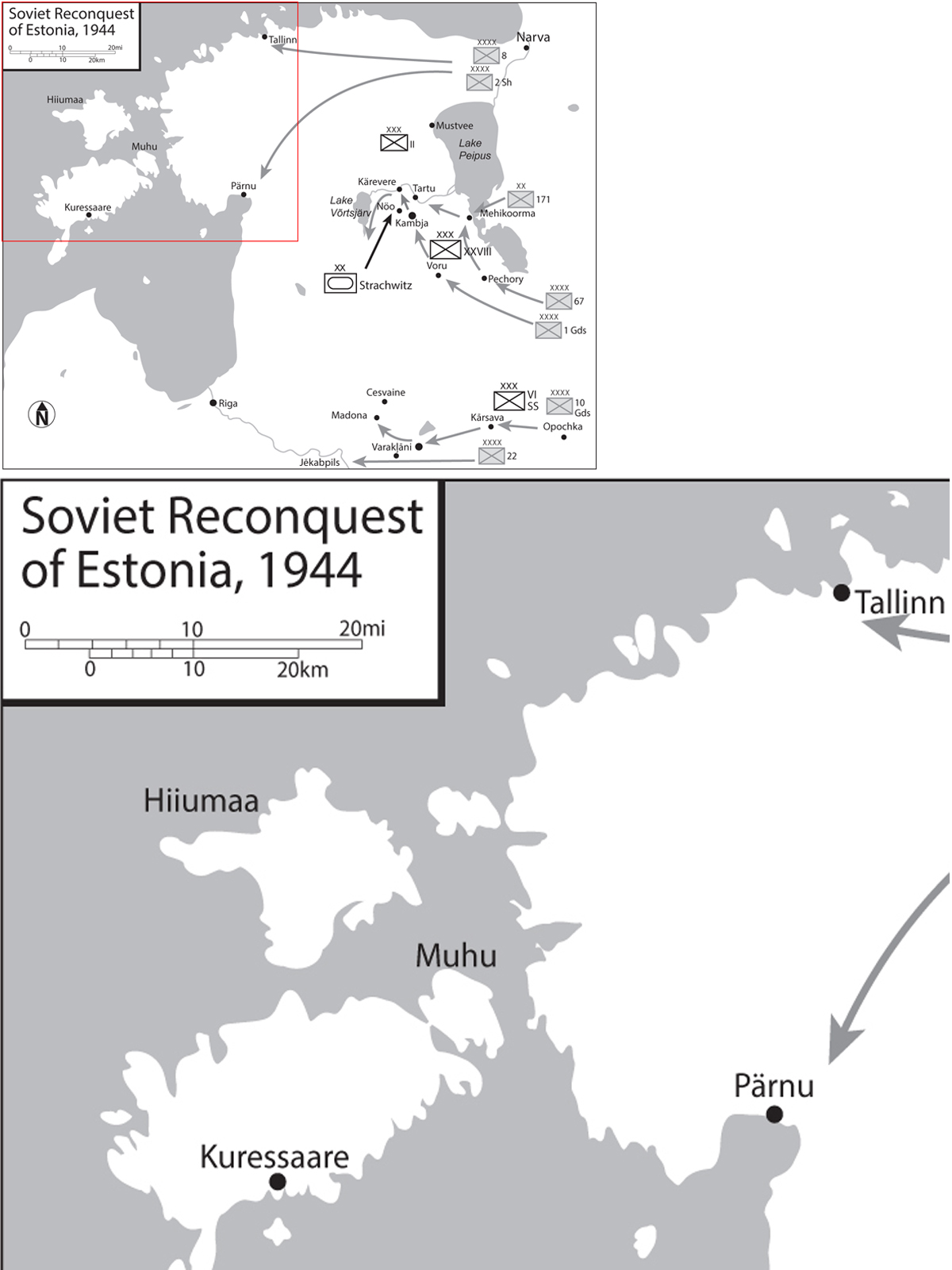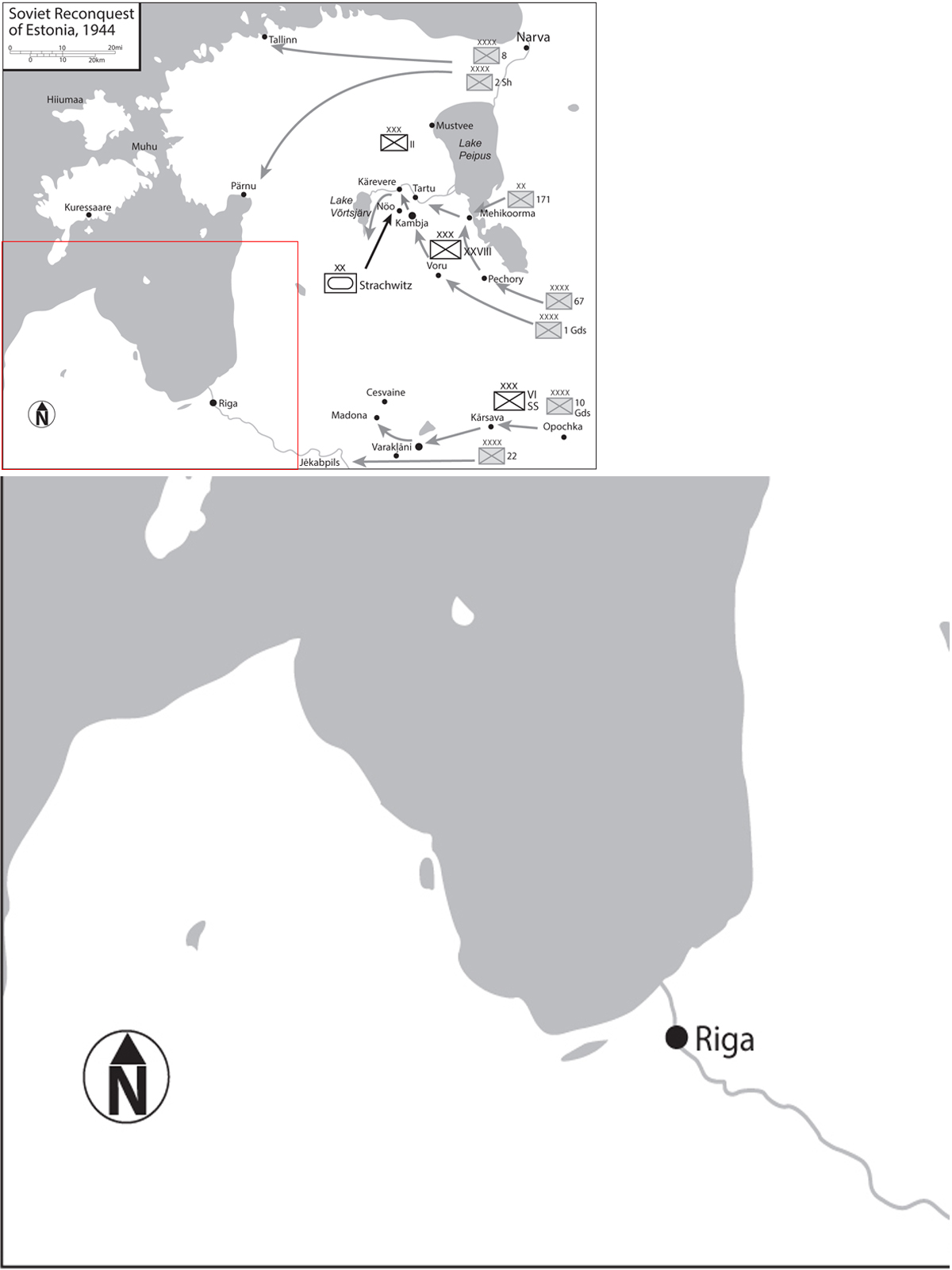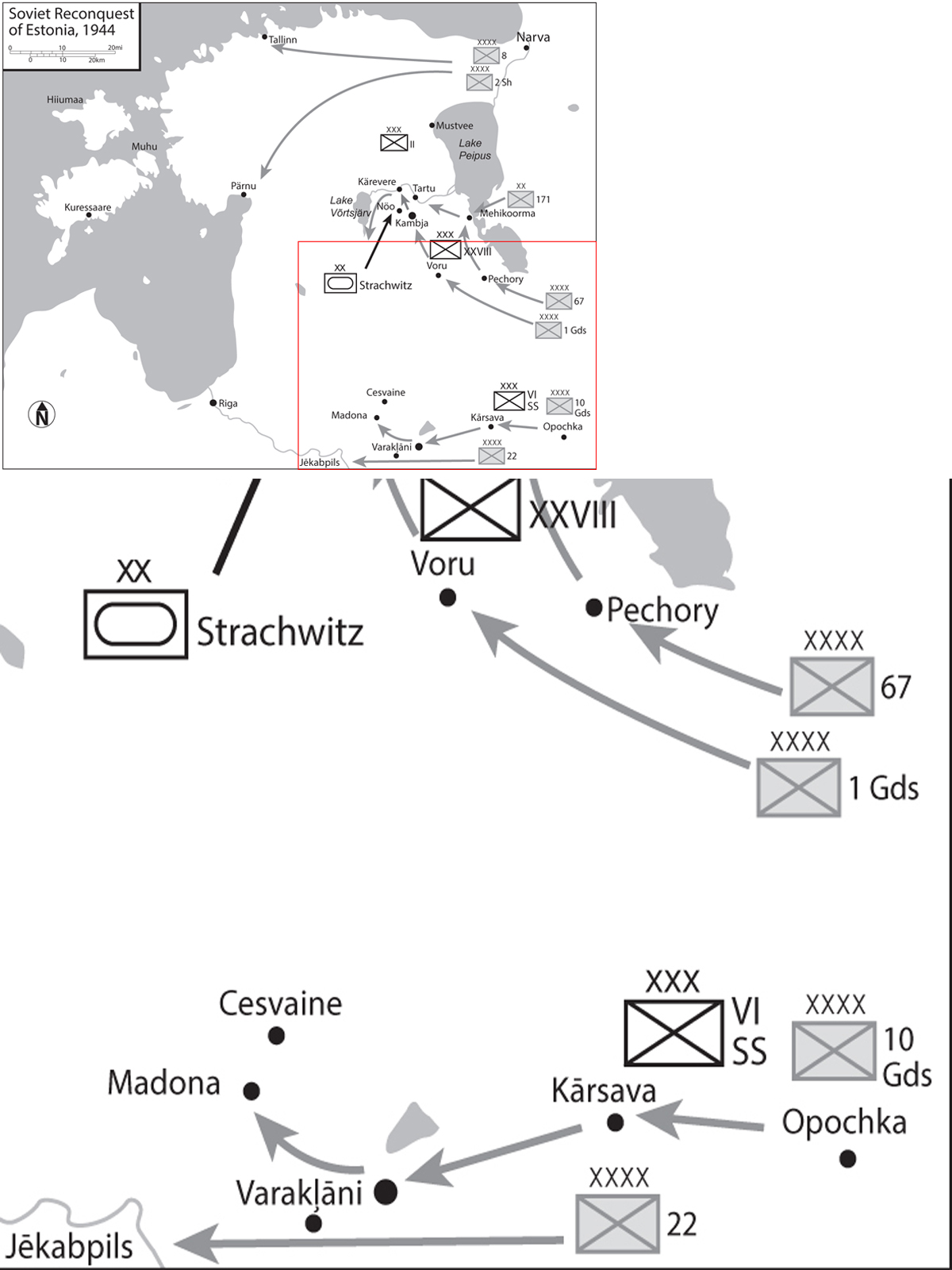Between Giants (43 page)
Authors: Prit Buttar
Tags: #Between Giants: The Battle for the Baltics in World War II

Bagramian later claimed that his front accounted for over 15,000 German casualties during the operation, and knocked out 380 tanks and assault guns.
35
German records show that at the beginning of the operation, the German divisions had a total of only 281 operational tanks and assault guns between them, and though replacement vehicles arrived during the course of the operation, the Soviet figures seem unrealistically high; inevitably, both sides were prone to exaggerate the losses of their enemies. The true number of casualties on both sides during this operation will never be known with any degree of accuracy.
During this entire period, there was more heavy fighting further north. In 1941, when the Wehrmacht had advanced apparently irresistibly towards Leningrad, there had been no significant fighting around Narva, unlike the Soviet efforts in 1944. There were two reasons for this. Firstly, the Red Army in 1941 was in complete retreat, and simply lacked the forces to contest the Narva region. Secondly, even if an attempt had been made, it would have been rendered irrelevant by the swift advance of German forces to the east of Lake Peipus. In 1944, the Red Army had tried in vain to batter its way into Estonia via the Narva positions, but now that the entire Eastern Front was hugely weakened, there was a possibility of outflanking the German defences, by invading Estonia from south of Lake Peipus, much as the Wehrmacht had used this route to bypass the Narva in 1941.
In the area south of Lake Peipus, Maslennikov’s 3rd Baltic Front enjoyed a substantial advantage over the German defences, and as a result of German transfers of forces to the stricken Army Group Centre outnumbered them over 4:1 in terms of men and armour, and over 14:1 in terms of artillery. To make matters worse, these ratios included large numbers of poorly equipped and poorly trained Estonian militia amongst the ranks of the German forces.
The Soviet forces launched their attack on 10 August. Hans Gollnick’s XXVIII Corps immediately came under pressure, and by the end of the day, the Soviet 67th Army had broken through the German lines. Pechory, the last major town on the Soviet side of the old border, fell to 67th Army the following day, while the neighbouring 1st Guards Army pushed on towards Voru, reaching and capturing the town on 13 August. It was clear that the weakened southern flank of the German 18th Army could not continue to hold the front line. Schörner therefore ordered that the sector from Lake Võrtsjärv to Lake Peipus was to be covered by Army Detachment Narva, allowing 18th Army to concentrate its limited forces between Lake Võrtsjärv and the Latvian border. Hastily, a defensive line was established to prevent a swift Soviet advance to the Baltic coast.
After a brief pause, Maslennikov’s armies had resumed their advance on 16 August, forcing back the weak 207th Security Division. There was a clear threat to the city of Tartu, and Army Detachment Narva now hurried to restore the front. Brigadeführer Jürgen Wagner was dispatched from III SS Panzer Corps with the last tanks and assault guns from the
Nordland
division and the
Nederland
brigade, a battalion of 5th SS Volunteer Assault Brigade
Wallonien
, artillery support, and an infantry regiment from 11th Infantry Division. The units began to arrive at the front late on 16 August, and swiftly incorporated local Estonian
Omakaitse
into their ranks. It remained to be seen how well this new defensive line would withstand the Soviet forces.
Earlier in the summer, Govorov’s Leningrad Front had laid plans for an amphibious assault across Lake Peipus to outflank the stubborn defences of Army Detachment Narva. Now, the flotilla that had been designated for the operation, commanded by Captain Arzhavkin, was assigned to Maslennikov, with a view to carrying out a crossing of the lake in conjunction with 3rd Baltic Front’s attack into southern Estonia. The flotilla consisted of about 40 small vessels, many of them armed, and in order to improve the chances of success of any amphibious operation, Soviet aircraft carried out repeated attacks against the port of Mustvee, on the north-west shore of Lake Peipus, from which the Germans operated a number of gunboats, and by the beginning of August, most of the German vessels had been sunk or damaged. Lieutenant General Alexei Aleksandrovich Grechkin, deputy commander of the 3rd Baltic Front, was given command of a mixed force, comprised mainly of 128th and 191st Rifle Divisions, and on 16 August, elements of 191st Rifle Division, covered by artillery on the east bank, crossed the narrow strait that divided Lake Peipus from Lake Pskov and landed at Mehikoorma, rapidly establishing a substantial bridgehead.
The local defences consisted merely of poorly armed Estonian
Omakaitse
fighters, who could do little to stop the Soviet landings. However, several squadrons of Stuka dive-bombers from Hans-Ulrich Rudel’s
Schlacht-Geschwader 2
attacked in the late morning, just as the second wave of Soviet troops was being ferried across the strait, inflicting heavy casualties. A third wave of troops was also bombed later in the day. It appears that Soviet planners had not anticipated any significant threat from the air, and it was not until 17 August that Soviet fighters put up serious resistance to German attacks. Despite the dive-bomber attacks, some 7,000 men were landed at Mehikoorma, where they gradually enlarged their foothold, linking up with 67th Army’s 86th Rifle Division late on 17 August.
36
Pressure on the German line was unremitting. A mixed force of Estonians and a battalion from 11th Infantry Division came under heavy assault on 20 August on the approaches to Tartu, and despite powerful artillery support, the German troops pulled back to Melliste, barely five miles from the city outskirts. Further west, the battalion from
Wallonien
drove Soviet spearheads from Kambja, but on 23 August, elements of 1st Guards Army resumed their drive towards Tartu. There were heavy losses on both sides before the Walloons gave up Kambja, pulling back to the west of Tartu. A little further west, a battalion from the 45th SS Grenadier Regiment (1st Estonian) was in the village of Nöo. The main defences stopped the Soviet drive, but the 282nd Rifle Division discovered a thinly manned stretch of front line west of the village. Accompanied by a tank brigade, the division bypassed the Estonian defences and pushed north five miles to Kärevere, seizing the vital bridge over the River Emajõgi.
With a serious threat developing to Tartu from the south-east, south and now the west, Army Group North attempted to restore the situation with an armoured counter-attack. Hyazinth von Strachwitz’s armoured group, fresh from its triumph in
Doppelkopf
, was hurried north to launch an attack from near the southern point of Lake Võrtsjärv, marching north-east to strike the 1st Guards Army in its flank. The intention was to thrust through Elva to Nöo, but the operation suffered a disaster on 23 August. Whilst driving to his headquarters, Strachwitz was involved in a serious car crash; the small
Kubelwagen
(amphibious vehicle, the German equivalent of a jeep) he was travelling in left the road and rolled over several times, killing both the driver and Strachwitz’s orderly officer. The
Panzergraf
himself suffered a fractured skull, fractured ribs, and injuries to arms and legs. He was fortunate to survive, and there was no question of him continuing in command of his tanks.




The following day, the assault group, consisting of 101st Panzer Brigade and SS Panzer Brigade Gross, attacked alongside
SS-Panzer-Aufklärungs-Abteilung 11
. Although the SS reconnaissance battalion managed to penetrate to Tamsa, a few miles south-west of Nöo, Soviet defences proved too strong for the main armoured group to achieve a significant penetration. In any event, elements of 1st Guards Army bypassed the northern flank of the armoured counter-thrust, and reached the lower tip of Lake Võrtsjärv. The Soviet spearheads were now barely 40 miles from the Baltic, threatening to isolate Army Detachment Narva in Estonia. The armoured counter-thrust was abandoned, and its forces fell back to defend against a further Soviet drive to the west.
The Soviet 67th Army was concentrating against Tartu, and launched a determined attack with four rifle divisions to take the city on 25 August. Bitter street-fighting reduced much of the city to rubble, but by the end of the day, the exhausted German defenders were forced to abandon Tartu and retreat north-east over the River Emajõgi. On either side of Tartu, Soviet infantry succeeded in crossing the river and securing small bridgeheads, and Wagner tried desperately to salvage his shattered units.
SS-Panzer-Aufklärungs-Abteilung 11
was now assigned to his command, and with its mobility and firepower, it succeeded in stopping several Soviet penetrations. Sturmbannführer Leon Degrelle, commander of the
Wallonien
assault brigade, succeeded in establishing a defensive line around the Soviet bridgehead north of Tartu, and overall command of the German front between Lakes Võrtsjärv and Peipus was assigned to General Wilhelm Hasse’s II Corps.
With the German lines in disarray and Soviet forces across the Emajõgi at several points, there was a danger of multiple Soviet advances, either west to the Baltic, north into the rear of the Tannenberg positions, or north-west to Tallinn. Estonian soldiers who had been serving as part of the Finnish
Jalaväerügement 200
(‘Infantry Regiment 200’) or
JR 200
, and had returned to Estonia as part of the amnesty declared at the beginning of August, had been formed into the 3rd Battalion, 1st Estonian Regiment, and were hurried south to the front. On 30 August, reinforced by an Estonian police battalion and a small force of German tanks, they attacked the Soviet bridgehead at Kärevere, which was defended by two rifle divisions. After a stiff fight, the Soviet forces fell back, and the Estonians not only eliminated the bridgehead, but also captured the bridge intact. Further attacks followed, reducing the Soviet bridgeheads closer to Tartu. By 6 September, elements of II Corps had reached the northern edge of the city, but could make no further progress.
To the south-west, 16th Army also came under heavy pressure as the Soviet 2nd Baltic Front attempted to force its way through to the coast. Most of the line was defended by the German
Korpsgruppe Risse
and
Korpsgruppe Wagner
, created from the remnants of burnt-out infantry divisions and whatever other men were available. General Paul Laux, commander of 16th Army, was killed when his reconnaissance plane was shot down by a Soviet fighter, and he was replaced by General Carl Hilpert. As much through Soviet exhaustion as their own efforts, the defenders were able to bring the Soviet attack to a standstill.